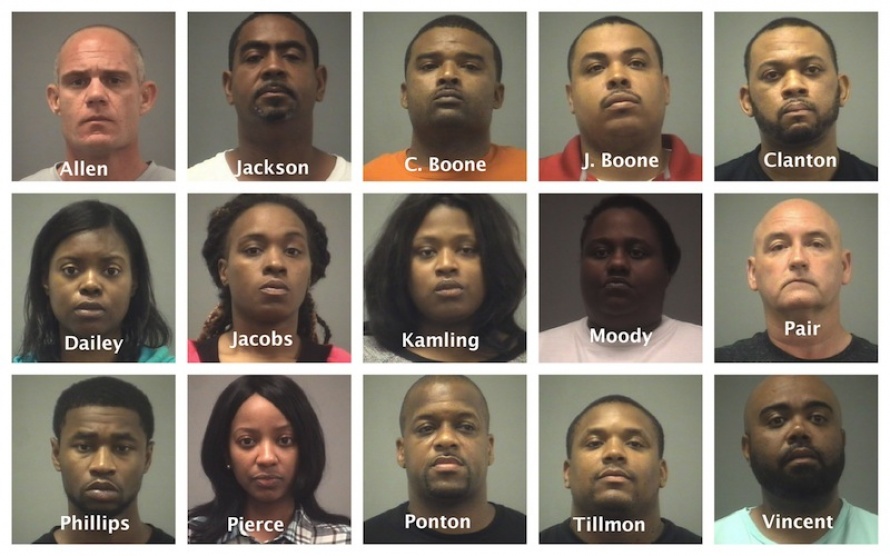United States Attorney Thomas G. Walker notes in his motion filed Tuesday that the FBI and and United States Attorney's Office initiated the investigation in response to allegations of systematic corruption within the Northampton County Sheriff's Office.
“During the course of the investigation, FBI undercover employees posed as members of a large-scale drug trafficking organization that transported narcotics and narcotics proceeds between Miami and New York,” the motion says. “The defendants believed that the DTO had recruited law enforcement officers in every state, from Florida to New York, to protect the DTO’s transport operations within that state’s borders.”
(Editor's note: We will report on the results of the detention hearing rulings once the ones scheduled for today are made)
Eventually, the motion says, “The DTO expanded its North Carolina operations and began flying in kilogram quantities of purported cocaine and heroin to the Northampton-Halifax Regional Airport. The defendants assisted in the transport of the purported cocaine and heroin, often while armed, in exchange for cash payments.”
Walker writes that the defendants understood that they were recruited to work for the DTO because of their status as law enforcement officers or ties to law enforcement. “Positions,” the document says, “that gave them the unique authority to protect the drugs from both law enforcement and criminals.”
The United States attorney says that, “Through the course of its investigation, the FBI captured the vast majority of the defendants’ conduct on extensive audio and video recordings and in surveillance photographs.”
The investigation led to a 54-count indictment that was unsealed, charging all defendants for, among other things, their participation in a drug distribution conspiracy spanning a period of one and a half years.
The indictment also charges all defendants with conspiring to use and carry firearms during and in relation to drug trafficking offenses. These conspiracies encompass multiple acts of possession with intent to distribute cocaine and heroin and the use and carrying of firearms during those offenses, as outlined in the indictment. Certain individuals are also charged with extortion, money laundering, and bribery.
Walker contends in the motion that the 15 pose a danger to the community. “The defendants are responsible for transporting over 100 kilograms of what they believed to be cocaine and heroin as it moved through South Carolina, North Carolina, Virginia, and Maryland. Many of them carried firearms while doing so in order to protect the drug load from other criminals.”
Walker continues, saying the evidence against the defendants establishes a sophisticated conspiracy involving the transport of multiple drug loads, each consisting of at least 10 kilograms of cocaine or heroin. “These offenses create a clear danger to the community.”
That the charges include the use and carrying of firearms demonstrated the reckless and dangerous consequences of their criminal conduct, Walker said.
The money laundering charges, he wrote, reflect that the defendants transported what they believed to be narcotics proceeds from out-of-state drug sales. Each money run involved amounts ranging from $250,000 to $1.5 million. “Finally, several defendants used their status as public officials to further their drug trafficking activities, making their crimes all the more egregious.”
“With the exception of Crystal Pierce and Tosha Dailey, each defendant was a current or former law enforcement officer or correctional officer,” the motion says. “These defendants accepted cash from what they believed to be members of a large-scale drug trafficking organization in exchange for using their status and badges to protect and harbor egregious criminal activity within the state of North Carolina. They took an oath to uphold the laws, but instead sold their office for corrupt and dangerous purposes. The nature and circumstances of the offense weigh strongly in favor of pretrial detention.”
At trial, Walker notes, the government will prove the defendants’ guilt through audio and video evidence showing the defendants planning and executing the transport of narcotics and narcotics proceeds, often while visibly armed.
The government will also offer at trial other physical and documentary evidence and the testimony of multiple witnesses, including FBI undercover employees.
While most of the defendants do not have a criminal history given that almost all of them worked as law enforcement or correctional officers, evidence, Walker says, “Will establish that most of the defendants participated in criminal conduct for an extended period of time. Further, the government will show that each defendant that worked in law enforcement or corrections abused his or her position and violated the very laws he was sworn to uphold. The government will provide particularized evidence during each defendant’s respective bail hearing.”
Wrote Walker, “The seriousness of the danger posed by the defendants’ release cannot be overstated in light of their affiliation with what they believed to be a large-scale drug trafficking organization, and their participation in the possession of narcotics with intent to distribute them to the community, their possession of firearms, and their status as current or former law enforcement or correctional officers.
“Based on these relevant factors and the statutory presumption discussed above, each defendant poses a serious danger to the community and should be detained pending trial.”
The defendants are serious flight risks, the motion says. “Each defendant faces up to life imprisonment on count one alone. Further, each defendant is charged in at least one crime that carries a substantial mandatory minimum penalty.”
The mandatory minimum penalties are as follows:
Lann Tjuan Clanton, 90 years for counts 4, 5, 10, 19, 20, 24, 28, 37, 38, 42, 43, and 48
Ikeisha Jacobs, 40 years for counts 10, 28, 33, 34, 48, and 49
Jason Boone, 65 years for counts 10, 19, 20, 24, 28, 37, 38, 42, 43, and 48
Wardie Vincent Jr., 40 years for counts 10, 19, 20, 24, 28, 37, 38, and 48
Adrienne Moody, 40 years for counts 10, 28, 33, 34, 48, and 49
Cory Jackson, 65 years for counts 10, 19, 20, 24, 37, 38, 42, 43, and 48
Jimmy Pair Jr., 65 years for counts 19, 20, 24, 28, 37, 38, 42, 43, and 48
Curtis Boone, 65 years for counts 19, 20, 37, 38, 42, 43, and 48
Antonio Tillmon, 40 years for counts 28, 33, 34, 48, and 49
Alaina Kamling, 40 years for counts 28, 33, 34, 48, and 49
Kavon Phillips, 40 years for counts 28, 33, 34, 48, and 49
Crystal Pierce, 15 years for counts 28, 33, and 34
Alphonso Ponton, 40 years for counts 37, 38, 42, and 43
Thomas Jefferson Allen II, 10 years for count 24
Tosha Dailey, 10 years for count 48
“The severity of each defendant’s possible sentence gives them a substantial incentive to flee,” Walker said.








